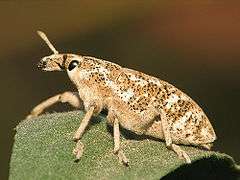Cyphocleonus achates
| Cyphocleonus achates | |
|---|---|
 | |
| Scientific classification | |
| Kingdom: | Animalia |
| Phylum: | Arthropoda |
| Class: | Insecta |
| Order: | Coleoptera |
| Family: | Curculionidae |
| Subfamily: | Molytinae |
| Tribe: | Cleonini |
| Genus: | Cyphocleonus |
| Species: | C. achates |
| Binomial name | |
| Cyphocleonus achates Fahraeus | |
Cyphocleonus achates is a species of true weevil known as the knapweed root weevil. It is native to southern Europe and the Mediterranean and is used as an agent of biological pest control against noxious knapweeds, especially spotted knapweed (Centaurea maculosa).
Life history
The adult weevil is dark gray and white speckled and 14 to 15 millimeters long. The female lays about 100 eggs during her 8- to 15-week adult lifespan. The eggs are deposited one by one in notches the female digs into the root crown of the knapweed. The larva emerges from the egg and tunnels into the root cortex where it feeds on the plant tissue. Sometimes a gall is produced in the feeding area. Adults feed on the leaves but it is the larva that does the most damage to the plant. Small plants can be killed by the larva's destruction of the root tissue. In their native range, most C. achates overwinter as 2nd instars, though in the introduced range, the vast majority overwinter as 1st instars.[1]
Biocontrol in North America
It was first released as a knapweed biocontrol in the 1980s in the United States. It is established in much of the western United States and there is evidence that it reduces knapweed biomass.[2][3][4] C. achates is thought to be responsible for a recent (2000s) observed decline in spotted knapweed, but this decline may also be attributable to a recent severe drought.[5][6] The weevil prefers spotted knapweed, but it is sometimes found on diffuse knapweed. It has not been shown to attack native flora.
C. achates was released to the Hiawatha National Forest in Michigan's Upper Peninsula in summer 2009.[7]
External links
References
- ↑ Janelle G. Corn; Jim M. Story; Linda J. White. "Comparison of Larval Development and Overwintering Stages of the Spotted Knapweed Biological Control Agents Agapeta zoegana (Lepidoptera: Tortricidae) and Cyphocleonus achates (Coleoptera: Curculionidae) in Montana Versus Eastern Europe". Environmental Entomology 38(4):971-976. 2009.
- ↑ Corn, J.G., Story, J.M., White, L.J., 2006. Impacts of the biological control agent Cyphocleonus achates on spotted knapweed, Centaurea maculosa, in experimental plots. Biological Control 37, 75–81.
- ↑ Jacobs, J.S., Sing, S.E., Martin, J.M., 2006. "Influence of herbivory and competition on invasive weed fitness: observed effects of Cyphocleonus achates (Coleoptera: Curculionidae) and grass-seeding treatments on spotted knapweed performance." (PDF). Environmental Entomology 35, 1590–1596.
- ↑ Janelle G. Corn; Jim M. Story; Linda J. White. "Effect of Summer Drought Relief on the Impact of the Root Weevil Cyphocleonus achates on Spotted Knapweed". Environmental Entomology 36(4):858-863. 2007.
- ↑ Dean Pearson; Yvette Ortega. "Managing Invasive Plants in Natural Areas: Moving Beyond Weed Control" (PDF). In: Weeds: Management, Economic Impacts and Biology ISBN 978-1-60741-010-2.
- ↑ Sturdevant, N., S. Kegley, Y. Ortega, and D. Pearson. 2006. Evaluation of establishment of Cyphocleonus achates and its potential impact on spotted knapweed. USDA FS FHP General Technical Report 06-08:1-9
- ↑ Janel Crooks. "Hiawatha Releases Biocontrol Insects to Control Invasive Knapweed Plants". US Forest Service.
- Coombs, E. M., et al., Eds. (2004). Biological Control of Invasive Plants in the United States. Corvallis: Oregon State University Press, 212.
- Stejskal, R. (2005b): Interesting records of some weevil species of the subfamily Lixinae (Coleoptera: Curculionidae) in southern Moravia with notes on their bionomics (Zajímavé nálezy několika druhů nosatců podčeledi Lixinae (Coleoptera: Curculionidae) na jižní Moravě s poznámkami k jejich bionomii). - Klapalekiana, 41: 63–69. Praha.